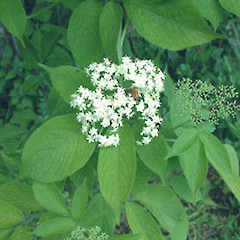Sambucus nigra
Common name
elder, elderflower, elderberry
Family
Adoxaceae
Flora category
Vascular – Exotic
Structural class
Trees & Shrubs - Dicotyledons
NVS code
The National Vegetation Survey (NVS) Databank is a physical archive and electronic databank containing records of over 94,000 vegetation survey plots - including data from over 19,000 permanent plots. NVS maintains a standard set of species code abbreviations that correspond to standard scientific plant names from the Ngä Tipu o Aotearoa - New Zealand Plants database.
SAMNIG
Conservation status
Not applicable
Habitat
Terrestrial. A plant of coastal and lowland habitats (Timmins & MacKenzie 1995). The plant occurs in scrub and forest margin and modified plant communities (Timmins & MacKenzie 1995).
Wetland plant indicator status rating
Information derived from the revised national wetland plant list prepared to assist councils in delineating and monitoring wetlands (Clarkson et al., 2021 Manaaki Whenua – Landcare Research Contract Report LC3975 for Hawke’s Bay Regional Council). The national plant list categorises plants by the extent to which they are found in wetlands and not ‘drylands’. The indicator status ratings are OBL (obligate wetland), FACW (facultative wetland), FAC (facultative), FACU (facultative upland), and UPL (obligate upland). If you have suggestions for the Wetland Indicator Status Rating, please contact: [Enable JavaScript to view protected content]
FACU: Facultative Upland
Occasionally is a hydrophyte but usually occurs in uplands (non-wetlands).
Detailed description
Shrub or small tree to approx. 6m high. Stems grey, strongly lenticellate; vegetative shoots with thick white pith. Leaflets 5~7, dark purple when very young, soon green. Petiole to around 7cm long on flowering branches, mostly hairy. Petiolules hairy; lateral petiolules < 1cm long; terminal petiolule > 1cm long. Lamina of terminal leaflet 4.5~11 x 3.5~6cm, broad-elliptic to broad-ovate, glabrous, or hairy on veins beneath and on midrib above, serrate except towards base; apex acute to cuspidate. Lamina of lateral leaflets smaller and narrower. Infl. a large flat corymb, mostly 10~20cm across, glabrous or nearly so, with slender peduncles and pedicels which usu. become red or purple at fruiting, or occasionally remain green. Flowers foetid. Calyx .5mm long. Corolla white; lobes 2.5~3mm long, broad-elliptic. Stamens < corolla. Fruit 4~8.5mm diam., globose or subglobose, usu. shining black, occasionally green. Pyrenes approx. 3mm long, ovoid-oblong, rugose. (-Webb et. al., 1988)
Similar taxa
Elder is a shrub or small tree (Porteus 1993).
Flowering
November, December, January
Flower colours
White
Life cycle
Perennial. Seed is produced (Timmins & MacKenzie 1995). Seeds are ‘short-lived’ in the seed bank (Atkinson 1997). Seed is dispersed by birds (Timmins & MacKenzie, 1995; John Barkla, pers. comm.).
Year naturalised
1867
Origin
Eur, W Asia, N Africa
Reason for introduction
Ornamental
Tolerances
The plant is intolerant of shade (Timmins & MacKenzie 1995). Requires medium to high soil fertility (Atkinson 1997).
Etymology
nigra: Black
Poisonous plant
The black berries can cause stomach upsets if eaten raw.







